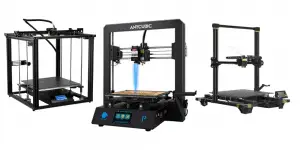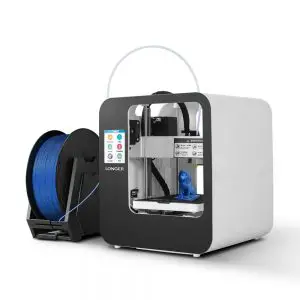Monoprice is an American company that distributes a variety of generic consumer electronics under their brand name. Our interest in them is based on their line of 3D printers. Some are in the post-2,000 dollar range, meant for industrial and professional high volume applications. But you can also get several entry-level models. Monoprice is good for absolute beginners, whether you are printing with resin or filament.
Today we will do a deep dive into the Monoprice Mini Delta 3D Printer, by Monoprice. It would be difficult to find a more economical starter printer for home and light educational use. Volume is low, and imperfections will be present, but if you do not need precision builds as part of your business, the Monoprice Mini Delta is an excellent choice.
Here is our usual rundown of the printer specs, followed by our extensive Monoprice Mini Delta review.
Monoprice Mini Delta Technical Specifications
- Max Print Size: 110 X 120 mm (4.33 X 4.7 inches) length by width
- File Format: G, GC, and GCODE.
- Supported Filament Types: ABS and PLA.
- Filament Diameter: Industry standard 1.75 mm.
- Printer Speed: Maximum is 150 mm per second.
- Extruders: Single nozzle
- Extruder Diameter: 1.4 mm
- Printing Plate: max heat 60 degrees Celsius (140 Fahrenheit).
Design and Features
The Mini Delta is built to be compact and take up little space on a tabletop or counter. It has an open triangular shape, with a rear angle that lets you place it in a corner out of the way. It reminds us of the teleporters from Star Trek–the triangular build plate is where Captain Kirk and Spock materialize, minus whatever nameless red-shirted extra died that week on a hostile planet.
The build plate is round and appears quite small, even compared to other budget wireless printers.
The open design makes everything easy to observe and work on, but the disadvantage is a tight working space. The size of the object you can make is limited by the height of the extruder, which hangs directly above the build plate and sprays the layers vertically.
Here are a few illuminating facts on those stats we gave you before.
The file formats are G, GC, and G-Code. If you use OBJ or STL, the software will convert them to G-Code for printing. In addition to ABS and PLA, you can use wood or PETG (polyethylene terephthalate glycol-modified) filament. PETG has some special applications that suit it to mechanical parts printing. PETG is known for its strength, toughness, and minimal shrinking. The finish is smooth, though any low-end filament printer will have tiny ridges and irregularities. If you want to make clothing or jewelry with the Mini Delta, PETG is your best bet. It will leave fewer irregularities to irritate skin. PETG also looks really nice in light, with a shiny, semi-transparent finished look.
The 140 F max temp is run of the mill for printers in this range. But you can get greater heat if you add 3rd party firmware, including some nice open-source programs. Higher temp will require a bigger power supply, too. You can find a lot of these tips and tricks on the Mini Delta wiki page. The page is maintained by users and customers who like the printer, not by Monoprice or its agents. Though it is aimed at beginners, Monoprice made the Mini Delta hackable and upgradeable for those who are inclined.
Control of settings is via a 3.4 inch IPS display, no touch screen. There are buttons on the front, and navigation is straightforward according to reviews and the Monoprice user’s manual that comes with the printer. The printer has wireless and Bluetooth connectivity and is compatible with Windows, Mac, and Linux boxes.
The aluminum bed can be automatically leveled, with most of the calibration and setup being done for you at the factory. The Mini Delta lets every beginner unbox it and begin creating right away.
Printing with the Monoprice Mini Delta
Printing is fast, up to 150 MM per second. You can get some volume out of this printer. The layer resolution is 50 microns. It’s perfect for the kind of projects a hobbyist would want to do, though of course some detail and precision are sacrificed. Prints are high quality and will be sufficient for some commercial applications, like making keychains or necklaces to sell on Etsy.
One word of caution: the build plate surface is thin. It would be easy to warp or tear when removing a sticky object. Always use the painter’s tape provided in the package, and replace it with an approved tape when it’s used up.
Delicate surfaces are not uncommon with printers of this size. It also means we recommend placing the printer with its rear angle in a corner, on a table butted all the way up against the wall. That leaves the printer no space to fall over or get knocked onto the floor. Such an accident would easily warp the build plate, and may not be covered by warranty. You can always pull the printer farther onto the table for easier reach when printing. The cord is long enough and the unit is light, weighing just 4 pounds.
Packing and Assembly
Besides the fully assembled Monoprice Mini Delta printer, you will find the following items in the box:
- Filament holder
- A plastic scraper to help in object removal
- USB cable
- Micro USB card
- A hex wrench (you’ll need this for setup)
- Power adapter
- AC power cord
When you place the printer in your workspace, make sure you have adequate ventilation. You’ll want to wear a breathing mask for certain types of filament. Always check the website for the filament manufacturer. The filament holder will be in a small parts box. You take it and slide it into 7 slots on the back of the frame. The Micro SD card goes into its own side port. The power cord and box are like any other, easy to connect and plug in.
Monoprice says to set the extruder temperature first, using the three buttons on the side of the lighted LCD screen. If you have ever used an iPad, iPod, or mobile phone, you’ll figure out the buttons and navigation in no time. Waiting for the extruder to heat up gives you time to open and insert your filament (not included). The scraper doubles as a tool for cleaning excess melted filament off the extruder, once printing is over and the extruder has cooled off.
Support
Monoprice has a great reputation for customer service. They will respond quickly to emails, phone calls, and instant messages from the support website. The company has a huge product line, and is worth over 100 million dollars, providing reliable low-cost electronics to home users all over the world. But they are still small enough to take the time to listen and help solve your issue. Any Monoprice Mini Delta review, from us or others, will praise the company’s commitment to its customers.
The fan wiki we linked to earlier is also a wealth of great information. It will tell you how to maintain and troubleshoot common problems. All the wiki information is based on Monoprice’s documentation and personal experience. If you need customer support outside Monoprice operating hours, the wiki is a good place to start. You can even find source code for the UI and other components on the wiki. The Mini Delta is not the only Monoprice 3D printer that has fans.
In addition to a 30 day guarantee, Monoprice provides a one year warranty on all their printers. The warranty covers repairs of any defects that arose on Monoprice’s end. It won’t cover damage from improper us. It isn’t clear whether you have to ship the printer back for warranty work or not. We definitely encourage you to contact Monoprice first, not the retailer where you purchased the printer.
Pros and Cons of the Mini Delta 3D Printer
PROS
- Price is competitive, less than many comparable products
- Monoprice sometimes offers refurbished and open box buys for an even lower price
- Initial setup is fast and painless, even for beginners
- The open frame makes it easier to clean the extruder and perform related tasks
- Can use a variety of filaments, not limited to ABS or PLA
- Compatibility with Windows, Mac OS, and Linux
- Possible to enhance capabilities with open source software, and shouldn’t be too difficult
CONS
- The aluminum print bed is delicate, small, and prone to damage with rough use
- Small size limits the size of printed objects
- Objects can stick, and taking them off too fast can damage the print bed
The Verdict
If you need a relatively fast printer for hobbyists or educational purposes, the Monoprice Mini Delta 3D Printer is your solution. It isn’t suitable for the volume of a large classroom, but you can use it as a backup or perhaps purchase several of them and connect them to the facility’s wireless. The metal and alloy construction is durable, but take extra care not to drop or knock over the printer. We’ve waded through a lot of user manuals, and we can say that the initial setup is one of the fastest and easiest we have seen. Though it’s inexpensive and not suitable for commercial makers, you do have the ability to hack, tweak, and upgrade this printer once you have a grasp on the basics. As its maker is fond of saying, the Monoprice Mini Delta may be small but it is not a toy.
Last update on 2025-06-06 / Affiliate links / Images from Amazon Product Advertising API






